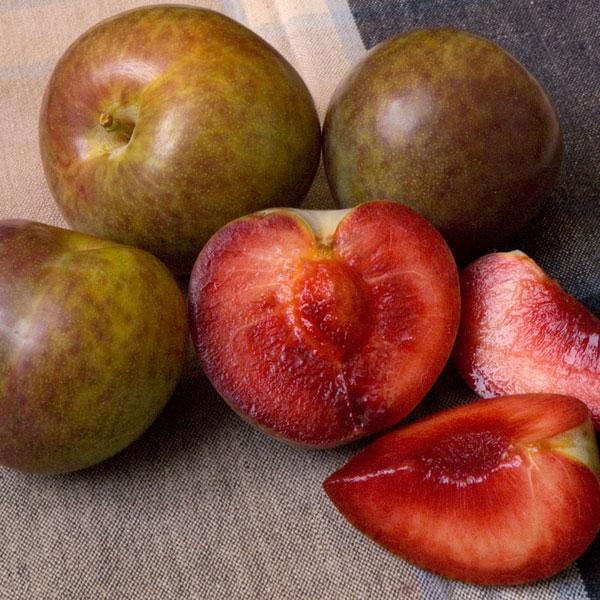Introduction
In the colorful world of hybrid fruits, few are as intriguing—or as delicious—as the pluot. A plum-apricot hybrid bursting with flavor, this stone fruit blends the sweetness of plums with the floral notes of apricots. Known for its smooth skin, juicy texture, and striking reddish purple hues, the pluot is a favorite among gardeners, orchard growers, and fruit lovers alike.
Some varieties feature yellow flesh, while others have rich, dark tones. Standouts like Flavor King offer intense king and flavor appeal, combining a bold taste with vibrant color. Whether you're drawn to the classic Dapple Dandy or the highly sought-after Flavor King, there’s a pluot variety for every palate.

The Story Behind the Pluot: A Modern Hybrid Marvel
The pluot’s history is rooted in the 20th century, when legendary plant breeder Floyd Zaiger of Zaiger Genetics built upon the pioneering work of Luther Burbank, who had earlier experimented with cross pollinated plums and apricots. Zaiger perfected these early crosses through natural hybridization—never genetic modification—creating what we now know as the pluot.
By backcrossing plumcots (half plum and half apricot) with plums over several generations, Zaiger achieved a fruit that’s roughly 75% plum and 25% apricot. This method enhanced sweetness, extended shelf life, and intensified color—qualities that make the pluot a standout among modern fruit hybrids.
In essence, a pluot is a hybrid that carries the best of both worlds: the juicy depth of a plum and the aromatic sweetness of an apricot.
Pluot Trees and Growing Conditions
Pluot trees resemble their plum relatives, thriving in sunny, warm climates. They prefer well-drained loamy or sandy soil and need about six to eight hours of sunlight per day. Because most pluot trees are not self-pollinating, you’ll need a compatible Japanese plum or another pluot nearby to ensure good fruit set.
Excellent pollinators include:
For water efficiency and healthy root development, use soaker hoses or drip irrigation to deliver moisture directly to the roots.
Explore the full range of pluot trees for your orchard or backyard garden.

Types of Pluots to Know
Each type of pluot offers its own distinctive look and taste—from speckled skin to heart-shaped fruits and ruby-colored flesh. Here are some of the most popular pluot varieties:
Flavor King Pluot
- Deep red skin and red flesh with a sweet, rich, and slightly tart flavor.
- One of the best-tasting varieties, often considered the gold standard of pluots.
- Available as the Flavor King Pluot Tree.
Dapple Dandy (Dinosaur Egg)
- Sometimes called the “dinosaur egg” for its mottled smooth skin.
- The juicy flesh is pinkish-red with a perfect balance of tart and sweet.
- Available as the Dapple Dandy Plumcot Tree.
Flavor Grenade
- Long, oval, and heart shaped, with crisp texture and tropical flavor.
- Green-yellow smooth skin and red flesh make it visually striking.
- Available as the Flavor Grenade Pluot Tree.

Flavor Queen
- Golden-yellow skin with honey-sweet taste and low acidity.
- Great for fresh eating or preserving.
- Available as the Flavor Queen Pluot Tree.
Splash Zaiger
- Small, vividly red skin and tangy-sweet juicy flesh.
- Great for kids’ snacks or salads.
- Available as the Pluot Splash Zaiger Tree.
Final Thoughts
From the iconic Flavor King to the speckled Dapple Dandy, pluots are proof that nature and human innovation can work beautifully together. These fruits deliver unforgettable sweetness, color, and aroma—making them a must-have addition to any garden or orchard.
Learn more about caring for fruit trees in our Fruit Tree Central hub.
FAQs About Pluot Varieties
What type of fruit is a pluot?
Are plumcots and pluots the same?
Are pluots genetically modified?
What is the best-tasting pluot variety?
How many varieties of pluots are there?
What is the difference between Flavor King and Dapple Dandy pluot?
What is a black pluot?
What is the best pollinator for Flavor King pluot?
What does a pluot fruit taste like?
Helpful Resources for Growing Pluots and Plum Trees
Whether you’re inspired by the fascinating history of the pluot or eager to grow your own at home, proper care and knowledge are key to success. These curated resources will help you select, plant, maintain, and troubleshoot plum and pluot trees—setting you up for a bountiful, flavorful harvest.
- Shop Plum Trees
- Bring home the foundation of your plum adventure. Browse our collection of premium plum trees—ideal pollinators and fruit producers.
- Optimal Growing Conditions for Pluots
- Learn the key factors for healthy pluot trees, including soil preferences, sunlight requirements, watering guidelines, and how to create an ideal environment for thriving fruit production.
- Companion Planting with Pluots: A Sustainable Approach
- Discover the benefits of pairing pluots with compatible plants to enhance pollination, reduce pests, and create a more sustainable orchard ecosystem.
- Organic Practices in Pluot Farming
- Explore eco-friendly methods for fertilizing, managing pests, and maintaining soil health—ensuring your pluot orchard is as sustainable as it is productive.
- Pluot Varieties and Their Characteristics
- Compare top pluot cultivars like Flavor King, Dapple Dandy, and Flavor Grenade by flavor, appearance, and bloom time to select the best varieties for your garden or farm.
- Pluot Cultivation Guide: A Comprehensive Approach to Growing Pluots
- Get an all-in-one guide that covers everything from site selection and planting to pollination, pruning, and harvesting for a fruitful pluot-growing experience.
With the right resources, you’ll be well-equipped to grow vibrant pluot trees, enjoy delicious hybrid fruit, and take part in a modern horticultural success story.

